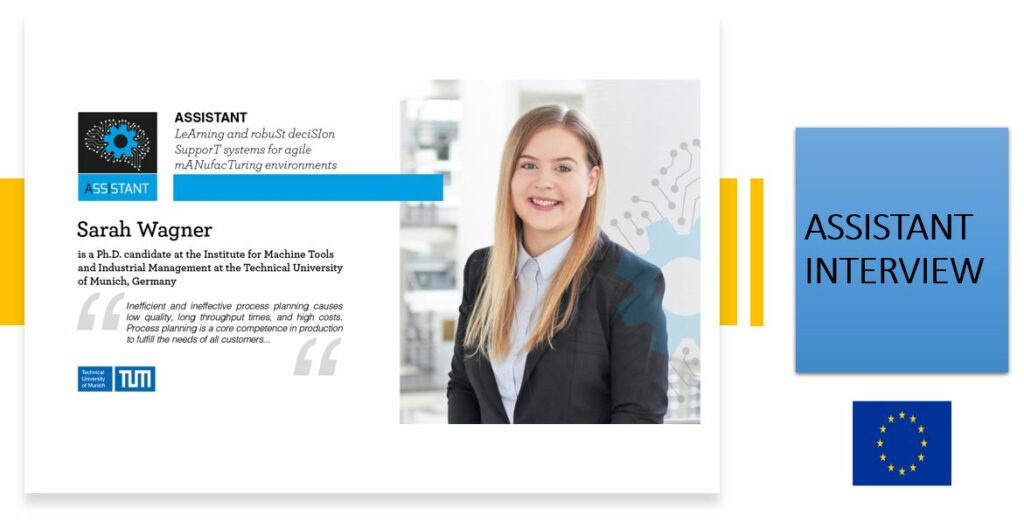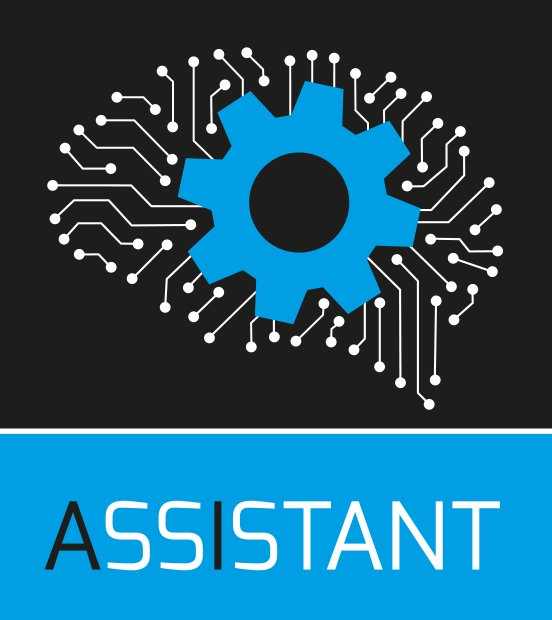
Sarah Wagner is a Ph.D. candidate at the Institute for Machine Tools and Industrial Management at the Technical University of Munich.
Her scientific achievements include developing a digital twin for order processing and a flexibilization strategy for technical change management. Her research focus comprises Data Analytics and Digital Twins in Production Management, and she is interested in Requirements Engineering and Change Management. Sarah Wagner holds an M.Sc. in Mechanical Engineering and will soon complete her second M.Sc. in Technology and Management. In the ASSISTANT Project, Sarah Wagner and TUM lead the development of a digital twin for process planning.
Félicien: Sarah, what is process planning, and why do industries need it?
Sarah: Process planning is a task between product design and its production. It covers planning activities to be carried out once for the effective and efficient production of a product. During process planning, process engineers identify all process steps and their sequence necessary to produce the product. They also assign the most suitable resources of an individual production system to each operation. Manufacturing industries require suitable process planning to avoid reduced process and product qualities, high production costs, and long throughput times. It is quite a crucial and highly influencing task for many industries, isn’t it?
Félicien: Indeed. So, it is a kind of selection and sequencing of processes and operations to transform raw material into a finished component, right?
Sarah: Yeah, they are part of process planning activities.
Félicien: Great, what inputs do we need for process planning, and what are the outputs?
Sarah: To plan production processes, process engineers need threedimensional information about the product to be produced and the current production system. Process engineers create possible process plans using analyzes of the product and the production system with its resources. Those derive which process steps are necessary to produce a product and assign the selected resources to each process step. The resource assignment includes the choice of required machines and operators with respective tools such as grippers and screwdrivers. Many possible process plans result from various process steps and different possibilities for resource allocations. For example, the same task can be performed manually by a human or automatically by a
robot. Therefore, process engineers must provide the optimal process plan among all possible alternatives.
Félicien: So, in short, the process planning will define the route that the raw material will follow through the manufacturing environment and a list of operations with the group of machines/resources that will perform them, right?
Sarah: Yes, that is it.
Félicien: What steps are necessary to implement process planning?
Sarah: We have to consider three main tasks to implement process planning: First, we need to identify all the process steps necessary to produce a product. Second, we have to compare product and process requirements with the capabilities of the production system. The comparison results in the assignment of possible resources to each production step. Last, we must select the best process plan from all alternatives. Methods like assembly sequence planning analyze the product to identify all process steps necessary to produce the product. They also derive requirements for each process step like weight constraints that the selected resources have to fulfill. We compare them with the resource capabilities. For example, the product weight must be less than the maximum load of the robot. If a resource realizes all demands, it can perform the respective task captured in the process plan. Collision and reachability simulations support checking the feasibility of all process plans and control the complex solution space. Alternative process plans are a result of process planning. In the end, process engineers select the best process plan depending on the relevance of different KPIs such as quality, time, or costs. Finally, we have to consider product and resource changes during process planning, and we need a suitable visualization to support process engineers and operators in executing the process plans. In summary, we need some complex components interacting with each other to plan processes, predict KPIs, optimize the process plan, and ensure user interaction.
Félicien: Amazing, why a digital twin for process planning? Which novelty will ASSISTANT bring to process planning comparing to the existing solutions?
Sarah: Manufacturing companies mainly use manual methods to perform process planning, and research already defines automatic methods for process planning. However, existing solutions do not connect these algorithms and do not consider historical data like changes and KPIs to predict and optimize process plans. Following several research contributions, we have identified the need for a digital twin for process planning. This digital twin holistically identifies alternative process plans and selects the optimal process plan by considering KPI predictions, simulations, and technical changes. Trends towards individualization and reconfigurability especially emphasize the need to create process plans automatically.
Félicien: That sounds good. How do you want to achieve this? Which technologies and methodologies do you use for the implementation of the digital twin for process planning?
Sarah: A mix of programming technologies supports the implementation of all algorithms involved in comparing product and
process requirements with resource skills. Collision and kinematic simulations help to check the feasibility of alternative process plans. Finally, several types of artificial intelligence technologies such as regression analysis, knowledge representation models, decision trees, genetic algorithms, and integer linear programming-based optimization techniques support the choice of optimal process plans.
Félicien: Clear, so how is process planning correlated with production planning and scheduling as well as with real-time actuation and control as further fundamental tasks between design and production?
Sarah: The resulting process plans are the direct input of both tasks. During planning and scheduling, production planners determine when and how often the production system executes all optimal process plans. The resulting production plans schedule the shop floor. If unpredicted downtimes or longer throughput times occur, the planners have to react in real-time. They can control the shop floor using the provided alternative process plans. If downtime occurs, the alternative process plans are selected depending on the availability of the assigned resources. This means that the Digital Twin is well
connected with the other tasks.
Félicien: It is clear that process planning is very important, so what kind of disaster can we expect if process planning is wrong or does not exist?
Sarah: Inefficient and ineffective process planning causes low quality, long throughput times, and high costs. Without process plans, companies do not have the know-how to manufacture and assembly their products. Either they do not know the necessary steps, or the resources capable of performing the process steps are not defined. Process planning is a core competence in production to fulfill the needs of all customers.
Félicien: Finally, what do you think of the ASSISTANT project?
Sarah: What I like most is the broad application horizon of the solutions to be developed. All solutions like the data fabric and each digital twin will address and assist many different companies by providing holistic decisions on the shop floor. The connection of all ASSISTANT tools will support all production preparation steps between design and production. It includes decision-making from process planning over production planning and scheduling to real-time control and actuation. Therefore, the tools assist a wide range of activities, and I appreciate that they will serve as enablers of diverse decisions in many branches. The cooperation with international partners with numerous skills also shows the potential of an interdisciplinary team. The experts from different fields already complement their skills. I am glad to work with this team and to develop holistic and breakthrough ASSISTANT solutions.
